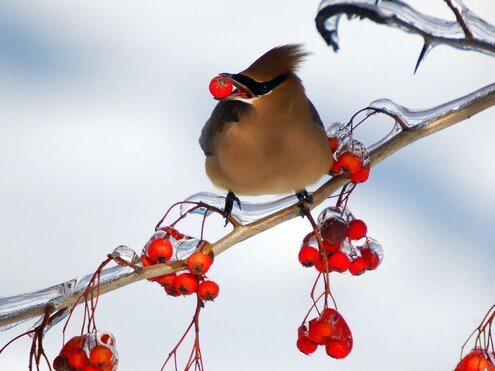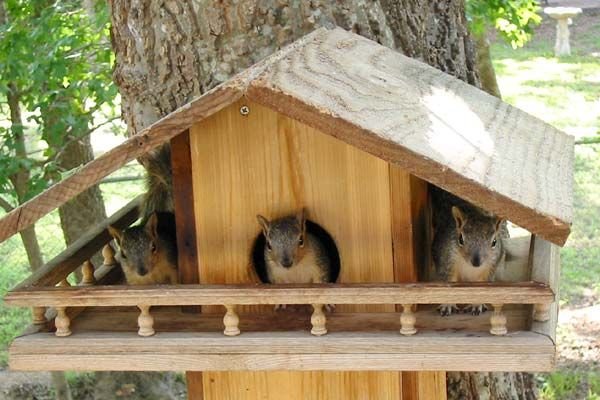Criteria 1 - Provide wildlife habitat
|
A healthy property has wildlife, birds, insects, soil life and the native plants they need, all working together as they do in natural ecosystems. And enjoying wildlife is a major benefit for you as the landowner too. If you have a diverse plant community in your yard, with many types and sizes of plants, you are well on your way to a conservation landscape that supports wildlife. Add plants that have flowers, fruits and nuts that are available at a variety of times of the year. It’s also important to consider vertical space as well as horizontal, and add plants that will reach different heights. Dense plants such as evergreens create cover for wildlife. And don’t underestimate the value of dead and dying plants, as hollow cavities and rotting wood, branches and brush piles, leaf litter and dried weeds all add habitat value to your landscape. So, it is often important to realize that neatness isn’t always the only thing that is beautiful! And, you’ll find that a landscape with diverse plantings and layers will have an attractive, landscaped appearance regardless. Mammals, birds, reptiles, amphibians, bees, butterflies and other insects and soil life are all vital. It’s important to consider all the needs that each of these types of animals have as you create habitat, including food, water and shelter. You can add food, feeders, houses, water features and other elements to help each of these types of creatures. Shelter includes hiding places, protection from the elements, and appropriate places for nesting and raising young. In addition to our wildlife habitat criteria, criteria 2 offer practices to create healthy soil conditions which support soil life as well as providing the basis for a healthy landscape. See the checklist and the resource guides below to help you with the details of creating habitat elements. Don’t forget that even a small residential yard can be a haven for nature...one participant counted 11 species of mammals visiting her yard located in the city as she added habitat elements. It’s easy to create places that offer a functioning, healthy ecosystem that our birds, insects, and wildlife need in the face of habitat loss, pests, and climate change. |
Recommendations:
 Large trees with cavities provide homes for wildlife...
Large trees with cavities provide homes for wildlife...
- •Provide areas of open soil (bare earth areas) for pollinator insects and burrows.
- •Water features are great habitat! Moving water will attract birds. There are many options, including wet meadows, rain gardens, vernal pools, ponds, natural wetland (encourage the native vegetation in each area), water features, fountains, bird baths, etc.
- •Provide shelter for wildlife, including areas of shrubs and trees, and other types of cover such as brush piles, rock piles and logs. You can also add constructed bird, wildlife (including bats) and bee houses and cover boards for reptiles and amphibians.
•Reduce human inputs including light at night, chemicals, noise, pets, non-permeable surfaces, etc. See our checklists for ideas.
•Collaborate with your neighbors, land trusts, and towns to create a larger network of ecologically healthy habitat areas!
Resources for Criteria 1:
National Resources
National Audubon Native Plants for Birds Database
National Wildlife Federation - Many ideas and a step-by-step process for creating wildlife habitat.
Xerces Society Lots of beautiful, useful books and publications on helping insects from bees, butterflies and other pollinators as well as other native beneficial insects.
Cornell University’s All About Birds - Lots of ways to learn about, help and enjoy birds on your landscape.
#BringBirdsBack - Strategies for stopping the steep decline in birds.
Bat Conservation International - Free bat house designs and other information on helping bats.
Maine Resources
Principles for Creating a Backyard Habitat for Wildlife - UMaine
Components of a Backyard Wildlife Habitat - UMaine
Of Pools and People - Lot of resources for learning about vernal pools, which are a very important habitat in our forests.
Maine Audubon - offers many relevant guides to managing land for habitat.
WIldlife in Maine Index - Maine Department of Inland Fisheries & Wildlife
National Audubon Native Plants for Birds Database
National Wildlife Federation - Many ideas and a step-by-step process for creating wildlife habitat.
Xerces Society Lots of beautiful, useful books and publications on helping insects from bees, butterflies and other pollinators as well as other native beneficial insects.
Cornell University’s All About Birds - Lots of ways to learn about, help and enjoy birds on your landscape.
#BringBirdsBack - Strategies for stopping the steep decline in birds.
Bat Conservation International - Free bat house designs and other information on helping bats.
Maine Resources
Principles for Creating a Backyard Habitat for Wildlife - UMaine
Components of a Backyard Wildlife Habitat - UMaine
Of Pools and People - Lot of resources for learning about vernal pools, which are a very important habitat in our forests.
Maine Audubon - offers many relevant guides to managing land for habitat.
WIldlife in Maine Index - Maine Department of Inland Fisheries & Wildlife
Find Us At:254 Goddard Rd
Lewiston, Me 04240 |
Contact Us:Project Director, Emma Lorusso
(207) 241-5374 [email protected] Technical Director, Sarah Torresen (207) 241-5377 [email protected] STAY UPDATED BY ADDING US ON : |


